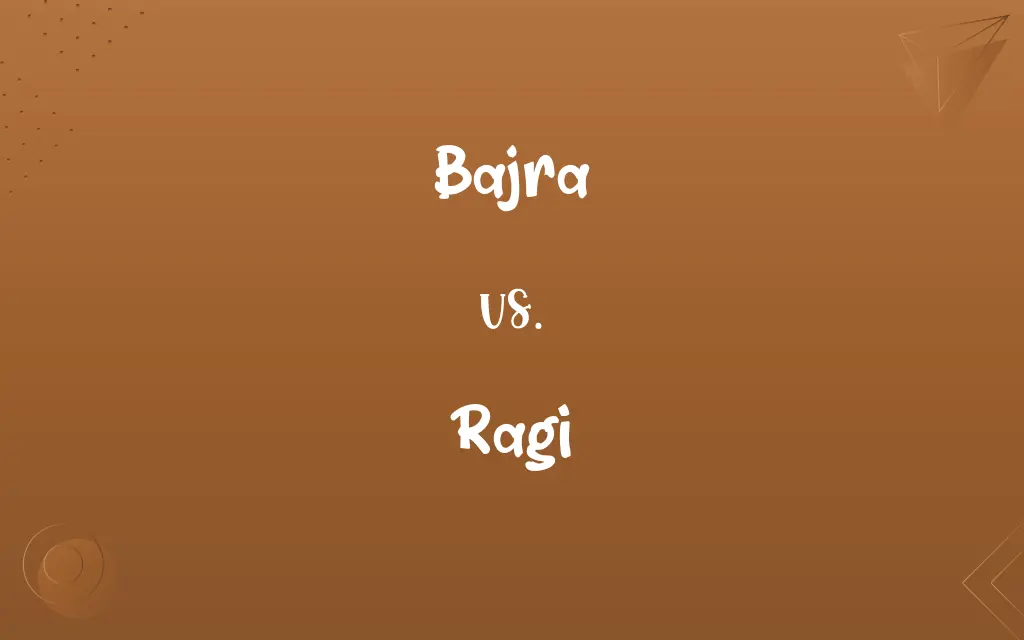Bajra vs. Ragi: Know the Difference

By Shumaila Saeed || Published on February 21, 2024
Bajra is a type of millet, coarse and used in various dishes. Ragi is also known as finger millet, rich in calcium and used in health foods.

Key Differences
Bajra is a type of pearl millet commonly used in Indian and African cuisines. Ragi, also known as finger millet, is widely consumed in Southern India and parts of Africa.
Shumaila Saeed
Feb 21, 2024
Bajra has a slightly nutty flavor and is used in making flatbreads like roti. Ragi is known for its high calcium content and is used in porridges and baked goods.
Shumaila Saeed
Feb 21, 2024
The cultivation of Bajra is suited for arid climates and is a staple in Rajasthan, India. Ragi thrives in slightly different climates and is a crucial crop in Karnataka, India.
Shumaila Saeed
Feb 21, 2024
Bajra is a rich source of phosphorus and fiber. Ragi, on the other hand, is particularly noted for its high iron and amino acid content.
Shumaila Saeed
Feb 21, 2024
In terms of culinary use, Bajra is often used whole or ground into flour. Ragi is versatile too, used in both savory and sweet dishes, including Ragi dosa and cookies.
Shumaila Saeed
Feb 21, 2024
ADVERTISEMENT
Comparison Chart
Nutritional Content
High in phosphorus and fiber
Rich in calcium, iron, and amino acids
Shumaila Saeed
Feb 21, 2024
Cultivation Region
Arid regions like Rajasthan, India
Various, including Karnataka, India
Shumaila Saeed
Feb 21, 2024
ADVERTISEMENT
Bajra and Ragi Definitions
Bajra
A type of pearl millet grain.
Bajra roti is a staple in many Indian households.
Shumaila Saeed
Jan 16, 2024
Ragi
High in calcium and iron, popular in health foods.
Ragi cookies are both delicious and nutritious.
Shumaila Saeed
Jan 16, 2024
Bajra
A coarse grain used in traditional Indian cuisine.
She made a warm bajra porridge for breakfast.
Shumaila Saeed
Jan 16, 2024
Ragi
Grown primarily in Southern India.
Ragi fields are a common sight in rural Karnataka.
Shumaila Saeed
Jan 16, 2024
Bajra
Nutrient-rich, especially in phosphorus and fiber.
Bajra is an excellent choice for a high-fiber diet.
Shumaila Saeed
Jan 16, 2024
ADVERTISEMENT
Ragi
Known as finger millet, a nutritious grain.
Ragi is often used to make healthy porridge.
Shumaila Saeed
Jan 16, 2024
Bajra
Cultivated mainly in arid regions.
Bajra is a common crop in Rajasthan due to its arid climate suitability.
Shumaila Saeed
Jan 16, 2024
Ragi
Used in traditional dishes like Ragi dosa.
Ragi dosa is a healthier alternative to the traditional rice dosa.
Shumaila Saeed
Jan 16, 2024
Bajra
Often ground into flour for various dishes.
Bajra flour is used in making gluten-free bread.
Shumaila Saeed
Jan 16, 2024
Ragi
Can be used in both sweet and savory recipes.
She experimented with ragi in both cakes and savory pancakes.
Shumaila Saeed
Jan 16, 2024
Ragi
A type of grain, Eleusine coracana, cultivated as a cereal in arid areas of Africa and Asia; finger millet.
Shumaila Saeed
Jan 14, 2024
Ragi
A type of yeast traditionally used in winemaking, baking, and brewing, now identified as Saccharomyces cerevisiae.
Shumaila Saeed
Jan 14, 2024
Ragi
East Indian cereal grass whose seed yield a somewhat bitter flour, a staple in the Orient
Shumaila Saeed
Jan 14, 2024
Repeatedly Asked Queries
Is Ragi beneficial for bone health?
Yes, due to its high calcium content, ragi is good for bone health.
Shumaila Saeed
Feb 21, 2024
What is Bajra?
Bajra is a type of pearl millet, commonly used in Indian and African cuisines.
Shumaila Saeed
Feb 21, 2024
What kind of climate is suitable for growing Bajra?
Bajra thrives in arid and dry climates.
Shumaila Saeed
Feb 21, 2024
How is Ragi incorporated in the diet?
Ragi is used in porridges, dosas, cookies, and many other sweet and savory dishes.
Shumaila Saeed
Feb 21, 2024
Can Bajra be used in gluten-free cooking?
Yes, bajra is gluten-free and often used in gluten-free recipes.
Shumaila Saeed
Feb 21, 2024
What does Ragi refer to?
Ragi, or finger millet, is a grain known for its nutritional value, popular in Southern India.
Shumaila Saeed
Feb 21, 2024
What are common dishes made from Bajra?
Bajra is used in flatbreads, porridges, and various traditional dishes.
Shumaila Saeed
Feb 21, 2024
Does Bajra require a lot of water for cultivation?
No, bajra is drought-resistant and requires comparatively less water.
Shumaila Saeed
Feb 21, 2024
Where is Ragi predominantly grown?
Ragi is mainly grown in Southern India, especially in Karnataka.
Shumaila Saeed
Feb 21, 2024
Is Ragi allergy common?
Ragi allergies are rare, but one should consult a doctor if they have grain allergies.
Shumaila Saeed
Feb 21, 2024
Is Bajra a good source of fiber?
Yes, bajra is high in fiber, making it beneficial for digestion.
Shumaila Saeed
Feb 21, 2024
How does the taste of Bajra compare to other grains?
Bajra has a slightly nutty flavor, distinct from other grains.
Shumaila Saeed
Feb 21, 2024
What makes Ragi different from other millets?
Ragi is distinct for its high calcium content and its suitability for various culinary uses.
Shumaila Saeed
Feb 21, 2024
Can Bajra be eaten daily?
Yes, bajra can be a part of a daily diet, especially in regions where it is a staple food.
Shumaila Saeed
Feb 21, 2024
Is Ragi good for people with diabetes?
Yes, ragi has a low glycemic index, making it suitable for people with diabetes.
Shumaila Saeed
Feb 21, 2024
Can Ragi be used in baby food?
Yes, due to its nutritional content, ragi is often used in baby food.
Shumaila Saeed
Feb 21, 2024
What is the shelf life of Bajra?
Bajra, when stored properly, can last for several months.
Shumaila Saeed
Feb 21, 2024
How is Bajra beneficial to health?
Bajra is beneficial due to its high fiber, phosphorus, and other nutrient contents.
Shumaila Saeed
Feb 21, 2024
What nutritional benefits does Ragi offer?
Ragi is rich in calcium, iron, and amino acids, making it highly nutritious.
Shumaila Saeed
Feb 21, 2024
Are there any gluten-free bread options made from Ragi?
Yes, ragi flour can be used to make gluten-free bread.
Shumaila Saeed
Feb 21, 2024
Share this page
Link for your blog / website
HTML
Link to share via messenger
About Author
Written by
Shumaila SaeedShumaila Saeed, an expert content creator with 6 years of experience, specializes in distilling complex topics into easily digestible comparisons, shining a light on the nuances that both inform and educate readers with clarity and accuracy.








































































